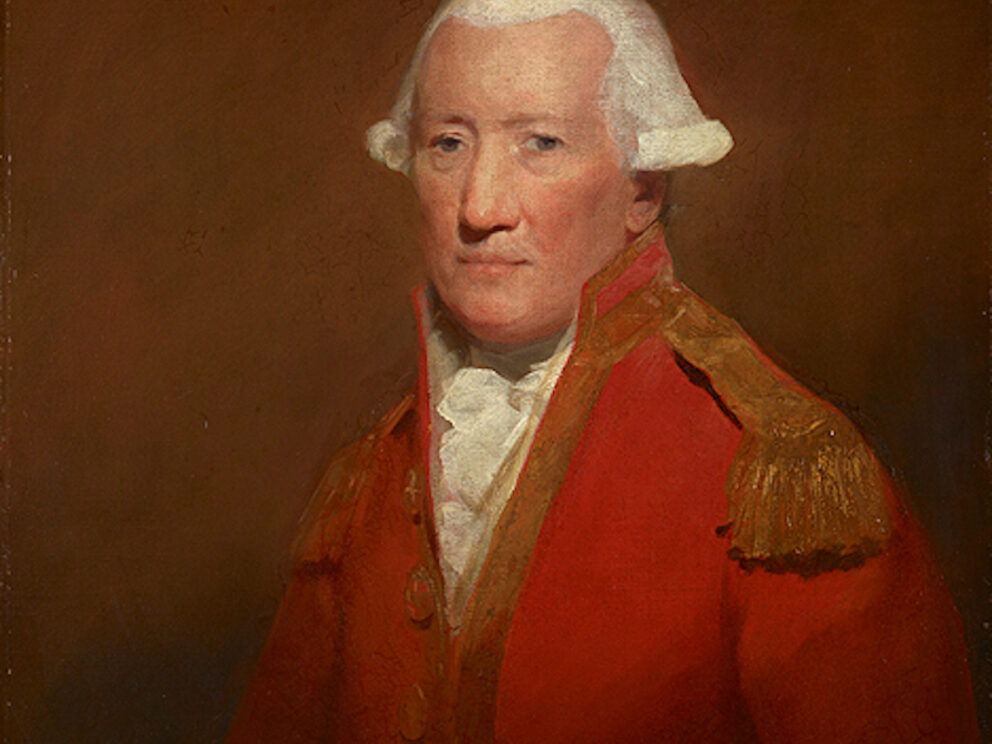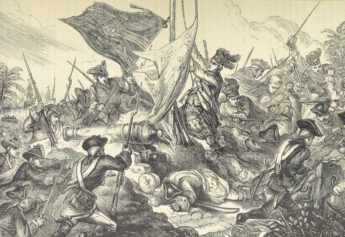A New Face in the Art Collection

We are delighted to welcome a new arrival to our Picture Gallery. The portrait of General Robert Melvill by Sir Henry Raeburn is part of our loan collection from National Galleries of Scotland and we are particularly pleased that General Robert has such relevance to our Paxton House story. Here, Dr Charles Fletcher, researcher at Paxton House, helps bring the portrait to life.
Robert Melvill and Paxton House
General Robert Melvill was the first British Governor of Grenada from 1764 to 1771 and had a close relationship with Ninian Home of Paxton House. Ninian was in Grenada following his purchase of the plantations of Waltham and Paraclete, the income from which helped him to purchase Paxton House in 1773. In the midst of the religious tensions Grenada experienced after it became a British possession in 1763, Melvill and Ninian Home, both presbyterian Scots, became important political allies.
Early life
Robert Melvill was born in the Fife village of Monimail in 1723. He was the son of the local parish minister, whilst his mother was the daughter of a local landowner, as such, he was a member of a junior branch of the Melville family (Earls of Leven and Earls of Melville). Melvill studied at Glasgow and Edinburgh universities before joining the army, against the wishes of his guardian, in 1744. He would go on to have a distinguished active military career. He fought at the battles of Fontenoy, Belgium, and at Culloden (against the Jacobites), before embarking for the West Indies during the Seven Years War. There, he was wounded during the capture of Guadeloupe from French forces but had the satisfaction of being appointed Lieutenant Governor of the island; he was subsequently appointed as Governor of Guadeloupe in 1760.

Anglo-French tensions in Grenada in 1764
After the treaty of Paris in 1763, which saw an end to the Seven Years War and the return of Guadeloupe to France, Melvill was promoted to the rank of Brigadier-General and appointed as Governor General and Commander in Chief of the ceded islands of Grenada, Dominica, Tobago and St Vincent. Melvill arrived in Grenada in 1764, where he would remain in post for seven years. He became leader of what was known as the ‘Scotch Party’ in Grenada, a contingent largely made up of presbyterian Scots who were vehemently opposed to a liberalisation of rights for Catholic dissenters in the ceded islands. This would allow French residents of Grenada, who had recently become subjects of the British crown, the right to vote in elections and sit in the island’s assembly. The issue was a contentious one, with many British residents in Grenada supporting the right of the naturalised French planters to participate in the political and civic life of the island. Melvill’s political affiliations suggest that he adhered to the view that Catholicism had no place in a British dominion. It was into the midst of this debate that Ninian arrived in Grenada in 1764.
Friends and Allies
We don’t know when Ninian first met Melvill; Ninian’s ownership of a half share in a sloop named ‘Melville’, registered in St Kitts in 1761, suggests that the pair may already have been friends prior to their arrival in Grenada. Nonetheless, Ninian’s decision, upon his arrival in the colony to ally himself with the anti-French faction in Grenada, proved to be a shrewd move in the fractious, religious riven, politics which would dog the island throughout Ninian’s tenure there. Ninian was one of eighteen British planters who wrote to Melvill in 1766 opposing the right of French Catholics in Grenada from voting in the elections of that year. Despite being tasked to repair relationships with the large French population in Grenada, Melvill came to whole-heartedly espouse the anti-French faction of which Ninian was a key member. Melvill had large powers of patronage at his disposal to reward his allies and political supporters and Ninian was a major beneficiary of this patronage. For instance, Ninian quickly found himself appointed as an assistant judge in the Court of Common Pleas. Furthermore, in 1765, Ninian was elected a member of the Grenadian lodge of the Beggars Bennison and Merryland, a notorious Scottish gentlemen’s sex club, in Grenada by Robert Melvill who was the lodge’s Grand Master. When the second elections to the island’s assembly were held in 1767, Ninian was returned as a member and duly chosen to be the house’s speaker. However, this anti-Catholic politics of patronage had calamitous consequences for Grenada.
Events leading up to rebellion in Grenada
According to the historian Dr David Alston, Mevill was a ‘disastrous and venal governor’ whose worst crime was failing to hold those to account who were responsible for the torture of five enslaved people in 1766. This torture was partially authorised by Patrick Home’s future brother-in-law, John Graham of Dougalston (a justice of the peace, councillor, and friend of Melvill), as a means to extract false confessions from five enslaved people in relation to the murder of two white coopers. Three of the enslaved people subsequently died of their injuries whilst in prison awaiting execution. The two survivors were eventually pardoned. Melvill allegedly knew nothing of these proceedings until after they had taken place, nonetheless, he failed to admonish the three torturers, two of whom were soon appointed to sit as members of Melvill’s council. Melvill’s enemies also accused him of abusing enslaved women and acquiring land in the West Indies in a disreputable manner.
“a disastrous and venal governor”
These actions and Melvill’s politics met with serious disapproval among many of the plantation owners in Grenada. These opponents to Melvill went so far as to lodge a complaint with the Privy Council following the Grenada election of 1767 and waged a pamphlet war against him in the press. They asked for his removal, citing his ignorance of the public good and the constitution along with disturbing the peace of Grenada by ‘his implacable and ill-founded low resentments; by his little and mean preferences and affections; by the modelling the council to his mind and by the introduction of his creatures’. Upon Melvill’s departure from Grenada he left a society which was seriously divided. The seeds were sown for the conflict which would result in Ninian’s death in 1795 whilst he was Lieutenant-Governor of Grenada.
Melvill in Later Life
Following his departure from Grenada in 1771, Melvill returned to the academic studies that he had turned his back on in 1744. He undertook a grand tour of Europe with the intention of studying military history and antiquities. He won fame for inventing a mass-produced cannon and was respected for his antiquarian studies, as a result of which, he was elected as a fellow of the Society of Antiquaries, along with the Royal Society of London, and the Royal Society of Edinburgh. His proposers for the latter fellowship were among some of the most famous thinkers of the enlightenment: Adam Smith and James Hutton. Melvill died in 1809.
Raeburn’s portrait
Raeburn’s portrait of Melvill was probably painted in the late 1790s. The portrait lacks the fluency of his mature work, but already shows his ability to capture personality. Melville is shown as intelligent and thoughtful, but also distant and detached – administering the Empire, in spite of its cost in life and liberty.
The portrait, on loan from National Galleries of Scotland, enhances the ‘Caribbean Connections’ project, which recognises the impact and legacy of empire and slavery in relation to the history of Paxton House. This project was shortlisted for the Museums Change Lives Award: ‘Reimagining the Museum’ in November 2022.